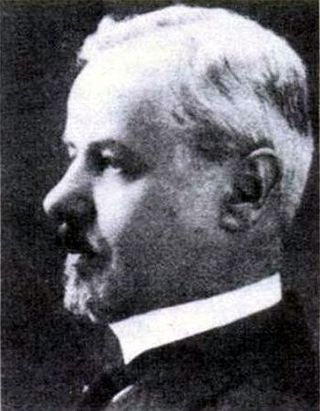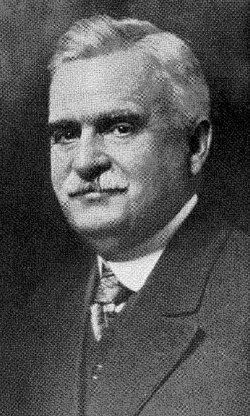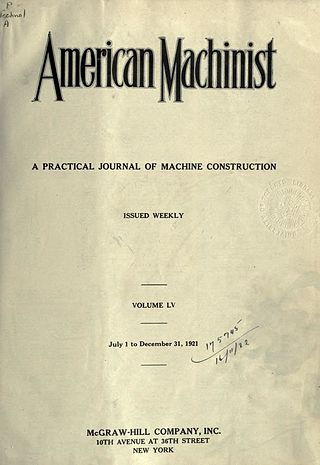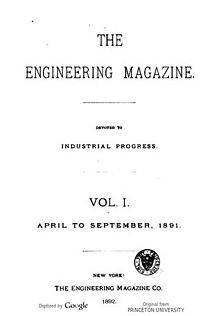Haridimos "Hari" Tsoukas is a Greek theorist on organization and leadership.

Alexander Hamilton Church was an English efficiency engineer, accountant and writer on accountancy and management, known for his seminal work of management and cost accounting.

A machine shop or engineering workshop is a room, building, or company where machining, a form of subtractive manufacturing, is done. In a machine shop, machinists use machine tools and cutting tools to make parts, usually of metal or plastic. A machine shop can be a small business or a portion of a factory, whether a toolroom or a production area for manufacturing. The building construction and the layout of the place and equipment vary, and are specific to the shop; for instance, the flooring in one shop may be concrete, or even compacted dirt, and another shop may have asphalt floors. A shop may be air-conditioned or not; but in other shops it may be necessary to maintain a controlled climate. Each shop has its own tools and machinery which differ from other shops in quantity, capability and focus of expertise.

Leon Pratt Alford was an American mechanical engineer, organizational theorist, and administrator for the American Society of Mechanical Engineers. known for his seminal work in the field of industrial management.
Yehouda Shenhav is an Israeli sociologist and critical theorist. He is known for his contributions in the fields of bureaucracy, management and capitalism, as well as for his research on ethnicity in Israeli society and its relationship with the Israeli-Palestinian conflict.

Industrial engineering is an engineering profession that is concerned with the optimization of complex processes, systems, or organizations by developing, improving and implementing integrated systems of people, money, knowledge, information and equipment. Industrial engineering is central to manufacturing operations.

Clinton Edgar Woods was an electrical and mechanical engineer, inventor, manufacturer of automobiles in Chicago and New York City. He was the author of one of the first books on electric vehicles, and an early management author.
Charles Oscar Eugene Perrigo was an American mechanical engineer, inventor, and early technical and management author, known for his work on machine shop construction and management, and for his work on lathe design, construction and operation.

Hugo Diemer was an American engineer, management consultant, and professor at the Penn State University, who in 1910 published the first industrial engineering textbook: Factory Organization and Administration.
Horace Lucian Arnold was an American engineer, inventor, engineering journalist and early American writer on management, who wrote about shop management, cost accounting, and other specific management techniques. He also wrote under the names Hugh Dolnar, John Randol, and Henry Roland.
Charles Edward Knoeppel was an American organizational theorist and consultant, who was among the foremost writers on management techniques early 20th century.
John Herbert Van Deventer was an American engineer, inventor, trade journal editor, and writer on engineering, management, and accounting. In the field of accounting Van Deventer contributed to the theory of discounted cash flow. During World War I he served as editor-in-chief of the American Machinist.
James Bray Griffith was an American business theorist, and head of Department of Commerce, Accountancy, and Business Administration at the American School of Correspondence in Chicago, known as early systematizer of management.
Frederick Arthur Halsey was an American mechanical engineer and economist, who was long-time editor of the American Machinist magazine, and particularly known for his 1891 article, entitled "The premium plan of paying for labor."
John Robertson Dunlap was an American journalist, editor and publisher of engineering magazines and books. He is known as founder of the Engineering Magazine in 1891, which in the early 20th century became the "quality magazine in the field of business management."

Charles DeLano Hine was an American civil engineer, lawyer, railway official, and Colonel in the United States Army. He receives academic credit for studying organizations as a separate field, rather than a "smaller sister of sociology.".
Charles Underwood Carpenter was an American business manager, management author, and inventor, known as "one of the earliest advocates of the committee system in factory management."

The American Machinist is an American trade magazine of the international machinery industries and most especially their machining aspects. Published since 1877, it was a McGraw-Hill title for over a century before becoming a Penton title in 1988. In 2013 it transitioned from combined print/online publication to online-only.

Charles Day was an American electrical, construction and consulting engineer, and co-founder of Day & Zimmermann. He is known as a specialist in public utility management and operation, and for his seminal contributions to flow charts and the routing diagram.












